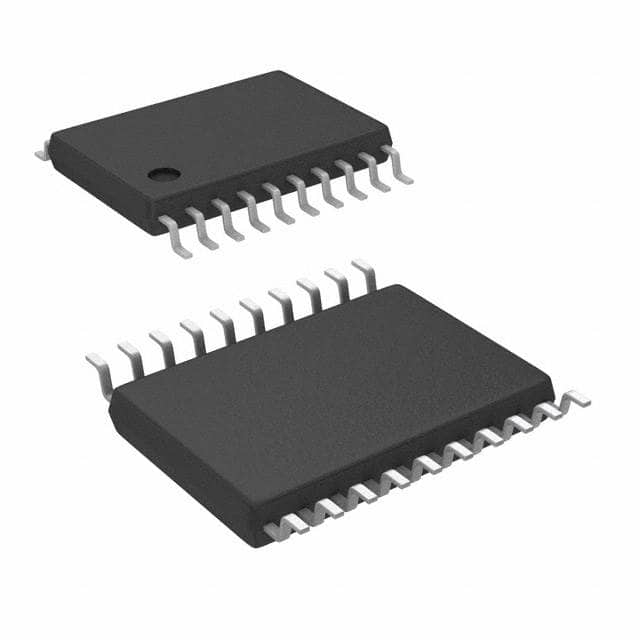Xem thông số kỹ thuật để biết chi tiết sản phẩm.

MM74HCT245MTC
Product Overview
- Category: Integrated Circuit
- Use: Level Shifter/Transceiver
- Characteristics: High-Speed, CMOS Technology
- Package: TSSOP (Thin Shrink Small Outline Package)
- Essence: Bidirectional Logic Level Shifter/Transceiver
- Packaging/Quantity: Tape and Reel, 2500 pieces per reel
Specifications
The MM74HCT245MTC is an integrated circuit that serves as a bidirectional level shifter/transceiver. It operates on high-speed CMOS technology, making it suitable for various applications requiring logic level shifting.
Detailed Pin Configuration
The MM74HCT245MTC has a total of 20 pins, which are arranged as follows:
- DIR - Direction Control Input
- OE - Output Enable Input
- GND - Ground
- A1 - Data Input/Output
- B1 - Data Input/Output
- B2 - Data Input/Output
- A2 - Data Input/Output
- VCC - Power Supply
- B3 - Data Input/Output
- A3 - Data Input/Output
- A4 - Data Input/Output
- B4 - Data Input/Output
- B5 - Data Input/Output
- A5 - Data Input/Output
- B6 - Data Input/Output
- A6 - Data Input/Output
- B7 - Data Input/Output
- A7 - Data Input/Output
- B8 - Data Input/Output
- A8 - Data Input/Output
Functional Features
The MM74HCT245MTC offers the following functional features:
- Bidirectional data transfer between two independent buses
- Voltage level shifting capability
- High-speed operation
- CMOS technology for low power consumption
- Output enable control for tri-state outputs
Advantages and Disadvantages
Advantages: - Bidirectional data transfer simplifies circuit design - High-speed operation allows for efficient data transmission - CMOS technology ensures low power consumption
Disadvantages: - Limited voltage range compatibility - Requires careful consideration of input/output voltage levels
Working Principles
The MM74HCT245MTC operates by receiving data from one bus and transmitting it to another bidirectionally. The direction of data flow is controlled by the DIR pin. When the DIR pin is set to a specific logic level, the data is transferred in the corresponding direction.
Detailed Application Field Plans
The MM74HCT245MTC can be used in various applications that require level shifting or bidirectional data transfer. Some potential application fields include:
- Microcontroller interfacing with different voltage level peripherals
- Communication systems involving multiple buses with different voltage levels
- Data acquisition systems requiring level translation between sensors and microcontrollers
Detailed and Complete Alternative Models
- SN74HCT245N - DIP package, similar functionality
- 74HCT245D - SOIC package, similar functionality
- CD74HCT245E - PDIP package, similar functionality
These alternative models offer similar features and functionality to the MM74HCT245MTC, providing options for different package preferences or availability.
In conclusion, the MM74HCT245MTC is a high-speed CMOS level shifter/transceiver integrated circuit. It offers bidirectional data transfer and voltage level shifting capabilities, making it suitable for various applications. While it has some limitations, such as voltage range compatibility, it provides advantages in terms of simplified circuit design and low power consumption.
Liệt kê 10 câu hỏi và câu trả lời thường gặp liên quan đến ứng dụng MM74HCT245MTC trong giải pháp kỹ thuật
Sure! Here are 10 common questions and answers related to the application of MM74HCT245MTC in technical solutions:
Q: What is MM74HCT245MTC? A: MM74HCT245MTC is a high-speed octal bus transceiver that can be used for bidirectional level shifting between different voltage domains.
Q: What is the operating voltage range of MM74HCT245MTC? A: The operating voltage range of MM74HCT245MTC is typically between 4.5V and 5.5V.
Q: Can MM74HCT245MTC handle both TTL and CMOS logic levels? A: Yes, MM74HCT245MTC is compatible with both TTL and CMOS logic levels.
Q: How many bidirectional channels does MM74HCT245MTC have? A: MM74HCT245MTC has 8 bidirectional channels, allowing for parallel data transfer.
Q: What is the maximum data transfer rate supported by MM74HCT245MTC? A: MM74HCT245MTC supports a maximum data transfer rate of up to 25 MHz.
Q: Can MM74HCT245MTC be used for level shifting between different voltage domains? A: Yes, MM74HCT245MTC is commonly used for level shifting between different voltage domains, such as between 3.3V and 5V systems.
Q: Does MM74HCT245MTC have any built-in protection features? A: Yes, MM74HCT245MTC has built-in diode clamps on all inputs and outputs to protect against electrostatic discharge (ESD) events.
Q: Can MM74HCT245MTC be used in both digital and analog applications? A: No, MM74HCT245MTC is primarily designed for digital applications and may not be suitable for high-precision analog signals.
Q: What is the typical power consumption of MM74HCT245MTC? A: The typical power consumption of MM74HCT245MTC is around 10mW.
Q: Is MM74HCT245MTC available in different package options? A: Yes, MM74HCT245MTC is available in various package options, including SOIC, TSSOP, and PDIP.
Please note that these answers are general and may vary depending on specific datasheet specifications and application requirements.

